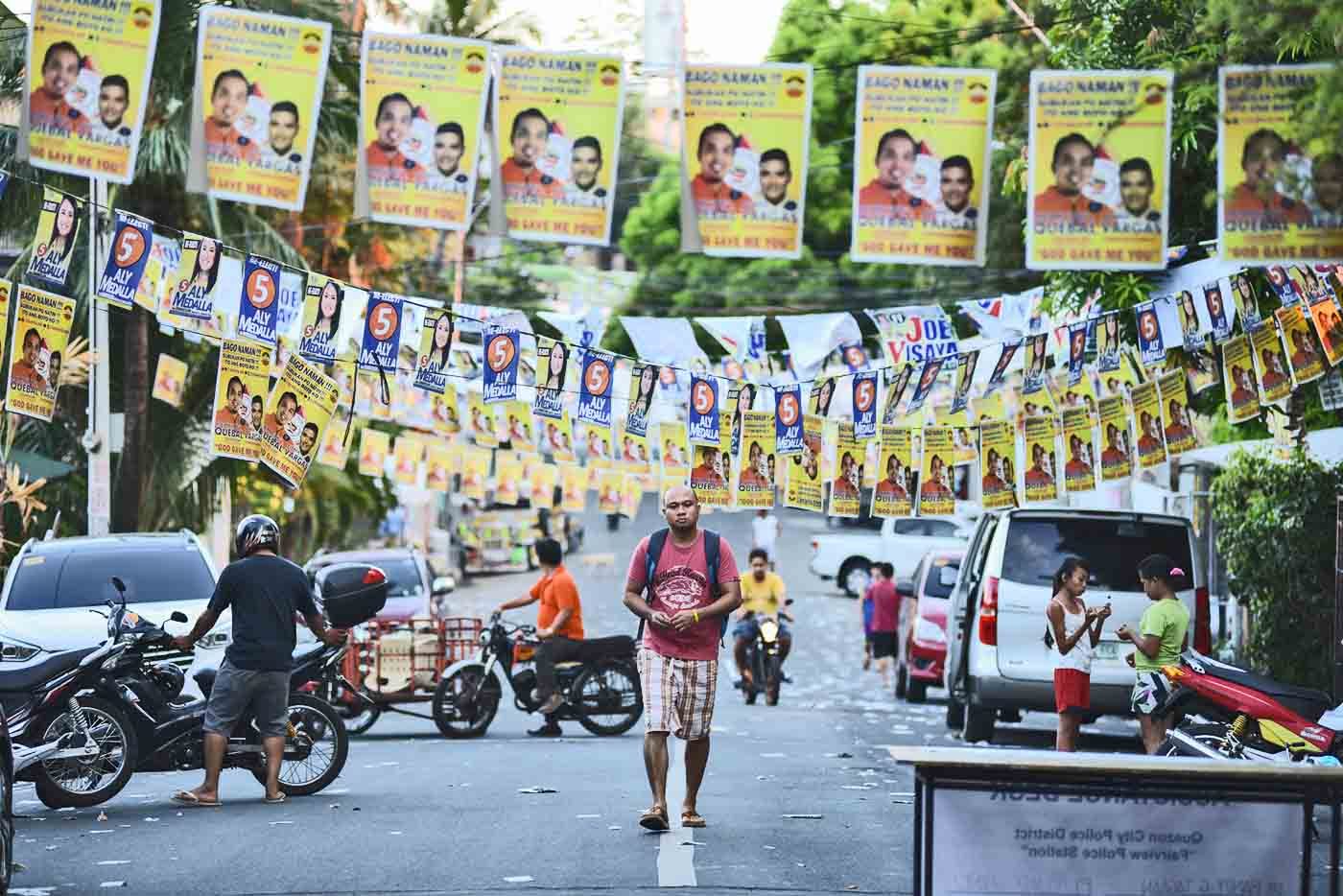SUMMARY
This is AI generated summarization, which may have errors. For context, always refer to the full article.

MANILA, Philippines – Posters, jingles, slogans, motorcades, and more.
Voters will see and hear these again, as candidates in the barangay and Sangguniang Kabataan (SK) elections 2018 gear up for the campaign period, scheduled from May 4 to 12.
Aspiring barangay and SK officials will surely have their own tactics and gimmicks during the campaign period, but these would need to comply with the rules set by the Commission on Elections (Comelec).
The rules on campaign ads and materials are contained in Comelec Resolution Number 10294, in line with Republic Act 9006 or the Fair Elections Act.
Common rules
Candidates can only spend P5 per registered voter in his or her barangay.
Lawful election propaganda include:
- Pamphlets, leaflets, cards, decals, stickers, or other written/printed materials not exceeding 8 1/2 inches in width and 14 inches in length, or the size of a legal-sized bond paper
- Handwritten or printed letters urging voters to vote for or against any candidate
- Posters made of cloth, paper, cardboard, or any other material – whether framed or posted – with a size not exceeding 2 feet by 3 feet
- Streamers for public meetings or rallies with a maximum size of 3 feet by 8 feet, which may be displayed 5 days before such meeting/rally and must be removed within 24 hours afterwards
- Mobile units or vehicle motorcades of all types, with or without sound system, and with or without lights
- Paid advertisements in print or broadcast media (see related rules below)
These materials can only be posted in common poster areas authorized by the Comelec or in public places as defined by the poll body. It may also be placed in private properties, but with the consent of property owners.
Lawful election propaganda, except for banners and streamers, may also be displayed in the candidates’ residences.
Comelec encourages candidates to use recyclable and environment-friendly materials. As such, the poll body requires candidates to indicate in their materials the phrase, “This material should be recycled.”
All election propaganda – whether printed, broadcast, or published – must:
- Identify the candidate whom the ad is for (with the words “Political advertisement paid for” followed by the candidate’s name and address)
- Identify the one who paid for these ads (with the words “Political advertisement paid by” followed by the payor’s name and address)
If the space for a printed or online ad is donated by a publishing firm or the airtime is given free of charge by a TV or radio station, the propaganda should bear the phrase “Printed free of charge” or “Airtime for this broadcast was provided free of charge by,” followed by the name and address of the publishing firm or broadcast entity.
These notices should be reasonably legible, readable, or audible.
TV, radio ads

Barangay and SK bets are allowed to have a total of 60 minutes of TV ads per station, and a maximum of 90 minutes of radio ads per station.
If two or more candidates are in a TV or radio ad, the length of time they appear or are mentioned in it will be counted against their airtime limits.
An appearance or guesting in a newscast, news interview, news documentary, or on-the-spot coverage of news events “shall not be deemed to be broadcast election propaganda” and thus will not be counted against their airtime limits. Comelec, however, instructs broadcast media entities to give prior notice – or within 24 hours after first broadcast – on such items.
Candidates will be charged a 30% discounted rate for TV ads, and a 20% discounted rate for radio ads.
Print ads
The maximum sizes of print ads for each barangay and SK candidate are:
- 1/4 of a page, for broadsheets
- 1/2 of a page, for tabloids
Print ads, whether purchased or free of charge, “shall not be published more than 3 times a week per newspaper, magazine or other publication during the campaign period.”
Coordinated print ads featuring more than one candidate may be published. The size and frequency limitations “shall apply to each candidate appearing, mentioned or promoted in such a coordinated advertisement.”
Candidates will be charged a 10% discounted rate for print ads.
Meanwhile, when charges are aired against candidates, Comelec provides for a “right to reply” process in broadcast or print media.
Online ads
Comelec set the following maximum sizes of various online propaganda for each candidate:
| Name | Width (in pixels) |
Height (in pixels) |
Aspect ratio |
| Rectangles and pop-ups | |||
| Medium | 300 | 250 | 1.2 |
| Square pop-up | 250 | 250 | 1 |
| Vertical rectangle | 240 | 400 | 1.67 |
| Large rectangle | 336 | 280 | 1.2 |
| Rectangle | 180 | 150 | 1.2 |
| 3:1 rectangle | 300 | 100 | 3 |
| Pop-under | 720 | 300 | 2.4 |
| Banners and buttons | |||
| Full banner | 468 | 60 | 7.8 |
| Half banner | 234 | 60 | 3.9 |
| Micro-bar | 88 | 31 | 2.84 |
| Button 1 | 120 | 90 | 1.33 |
| Button 2 | 120 | 60 | 2 |
| Vertical banner | 120 | 240 | 2 |
| Square button | 125 | 125 | 1 |
| Leaderboard | 728 | 90 | 8.09 |
| Skyscrapers | |||
| Wide skyscraper | 160 | 600 | 3.75 |
| Skyscraper | 120 | 600 | 5 |
| Half-page ad | 300 | 600 | 2 |
These online ads, whether purchased or free of charge, “shall not be published more than 3 times a week per website during the campaign period.”
The display of such online ads “for any length of time, regardless of frequency, within a 24-hour period, shall be construed as one instance of publication,” added Comelec.
Not counted are broadcast programs “which are the main content of online streaming or video website pages.”
Comelec Resolution 10294 also stated that personal opinions, views, and preferences for candidates posted in blogs or micro-blogs (like posts or status updates on social media) “shall not be considered as acts of election campaigning or partisan political activity unless expressed by government officials” in the 3 branches of government, constitutional commissions, the civil service, the military, and other para-military units.
Reporting requirements
Both winning and losing candidates must report their campaign expenses in their Statement of Contributions and Expenses (SOCE), to be submitted to the Comelec by June 13.
Mass media entities must submit to Comelec all copies of advertising contracts it entered with candidates, along with copies of official receipts issued to the candidate or donor who paid for the ads.
Mass media entities and website owners must also submit to the Comelec the certified true copies of broadcast logs, certificates of performance, affidavits of publication, or similar records “for review and verification of the frequency, date, time and duration of advertisements aired for any candidate.”
Contractors and businesses that have election-related transactions with candidates should likewise report to the Comelec such expenditures, along with copies of official receipts, within 30 days after the polls. – Rappler.com
Add a comment
How does this make you feel?
There are no comments yet. Add your comment to start the conversation.